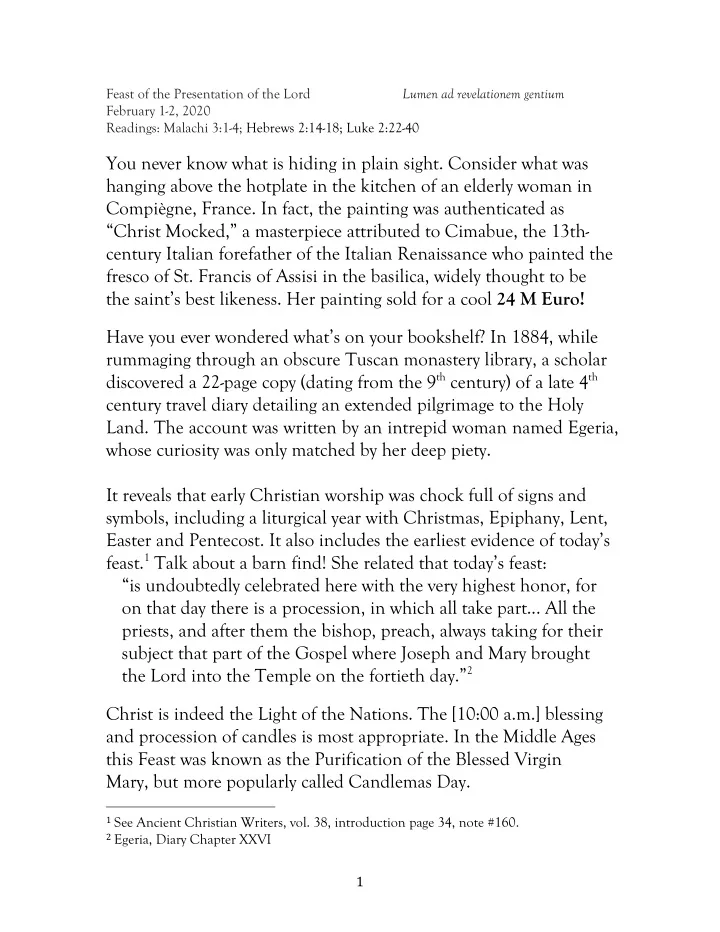

Feast of the Presentation of the Lord Lumen ad revelationem gentium February 1-2, 2020 Readings: Malachi 3:1-4; Hebrews 2:14-18; Luke 2:22-40 You never know what is hiding in plain sight. Consider what was hanging above the hotplate in the kitchen of an elderly woman in Compiègne, France. In fact, the painting was authenticated as “Christ Mocked,” a masterpiece attributed to Cimabue, the 13th- century Italian forefather of the Italian Renaissance who painted the fresco of St. Francis of Assisi in the basilica, widely thought to be the saint’s best likeness. Her painting sold for a cool 24 M Euro! Have you ever wondered what’s on your bookshelf? In 1884, while rummaging through an obscure Tuscan monastery library, a scholar discovered a 22-page copy (dating from the 9 th century) of a late 4 th century travel diary detailing an extended pilgrimage to the Holy Land. The account was written by an intrepid woman named Egeria, whose curiosity was only matched by her deep piety. It reveals that early Christian worship was chock full of signs and symbols, including a liturgical year with Christmas, Epiphany, Lent, Easter and Pentecost. It also includes the earliest evidence of today’s feast. 1 Talk about a barn find! She related that today’s feast: “is undoubtedly celebrated here with the very highest honor, for on that day there is a procession, in which all take part... All the priests, and after them the bishop, preach, always taking for their subject that part of the Gospel where Joseph and Mary brought the Lord into the Temple on the fortieth day.” 2 Christ is indeed the Light of the Nations. The [10:00 a.m.] blessing and procession of candles is most appropriate. In the Middle Ages this Feast was known as the Purification of the Blessed Virgin Mary, but more popularly called Candlemas Day. 1 See Ancient Christian Writers, vol. 38, introduction page 34, note #160. 2 Egeria, Diary Chapter XXVI 1
While liturgically listed as a Feast of the Lord (thus it’s celebration it when it falls on a Sunday), there is a distinct Marian aspect to this feast– one of both purification and suffering. Jesus fulfilled God’s plan by being a “sign of contradiction” and Mary, the chosen vessel of the redeemer, submitted herself to the Law of Moses, not placing herself above it, but always as its servant. In our world today, darkness looms on the horizon, threatening to obscure the light of Jesus Christ. We must both be vigilant and tireless in bringing to light the truth of the Gospel and the truth of the Catholic faith. We must do so courageously, even as it is routinely ignored, viciously attacked or deliberately marginalized. Sadly, the shadows even emanate from within, as with the German Bishops’ Conference apparent insistence on doctrinal autonomy. Pope St. John Paul II taught that, “Simeon's words seem like a second Annunciation to Mary, for they tell her of the actual historical situation in which the Son is to accomplish his mission, namely, in misunderstanding and sorrow.” 3 In her great humility Mary sought favor, even though she herself was never apart from God’s favor. We can only wonder what Mary must have been thinking after hearing the stinging words of Simeon. How did she receive that prediction in her heart? “This child is destined for the fall and rise of many in Israel, and to be a sign that will be contradicted—and you yourself a sword will pierce.” Simeon had been waiting for the Messiah, assured by God that he would not see death before seeing the Lord’s Anointed One. Now, he could die. Was he deeply troubled, or instead a prophet? Mary had to ponder on these thoughts as she presented herself at the temple. But her deep faith moved her to a greater level of trust that whatever might happen, would happen according to God’s will. 3 Pope John Paul II, encyclical letter Redemptoris Mater , n.16, 25 March 1987 2
We present ourselves today to the Lord, perhaps even with a mixture of fear and awe. May we do so honestly, without hiding anything, without obscuring the teachings of Jesus by our sins. Rather, may we humbly trust that God will purify our intentions, allowing us to shine forth the light of Christ more brightly to a world so desperately in need of hope. 3
Recommend
More recommend